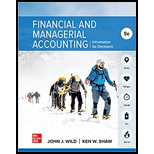
Concept explainers
Allowance method for
Write off method for accounts receivable: This is a method of accounting for writing off bad debts expense by directly writing them off from sales revenue for the period for which they are uncollectible. It has impact on both the income statement and as well as the balance sheet as it reduces the amount of accounts receivable.
To indicate: The given statements best describes either the allowance (A) method or the direct write off (DW) method.
Explanation:
1.
“No attempt is made to predict bad debt expense” is best described by direct write off (DW) method.
- As in the given statement there is no attempt is made to predict bad debt expense which means that there is no allowance has been made for bad debts or for doubtful accounts.
- So, allowance method cannot be applied here as there is no allowance account for doubtful accounts to be written off against accounts receivable.
Thus, the given statement is best described by direct write off (DW) method.
2.
“Accounts receivable on the balance sheet is reported at net realizable value” is best described by allowance (A) method.
- Since in the given statement the accounts receivable is reported on the balance sheet on net amount basis, it has been recorded after deducting the amount of allowance for doubtful account.
- So, allowance method must have applied as separate allowance account for doubtful accounts is there which has been used to be written off against accounts receivable.
Thus, the given statement is best described by allowance (A) method.
3.
“The write off of a specific account does not affect net income” is best described by allowance (A) method.
- Since in the given statement there is no effect of writing off an account on the net income.
- The method that has been used here must be allowance (A) method as it does not have any effect on income statement but affects the balance sheet of the company.
Thus, the given statement is best described by allowance (A) account.
4.
“When an account is written off, the debit is to bad debt expense” is best described by direct write off (DW) method.
- Since in the given statement write off of an account is resulting in the debit of bad debt expense account.
- In direct write off method also bad debt expense account is debited against accounts receivable to write off the loss, it is the case of direct write off method.
Thus, the given statement 4 is best described by direct write off (DW) method.
5.
“Sales and any bad debt expense are usually not recorded in the same period, thus, proper matching does not consistently occur” is best described by direct write off (DW) method.
- Since in the given statement matching does not occur consistently and in direct write off method also bad debt expenses are directly written off against accounts receivables
- The balances of the two usually do not get matched due to the amounts which belong to the different time period. So, the given statement is the case of direct write off method.
Thus, the given statement 5 is best described by direct write off (DW) method.
6.
“Requires a company to estimate bad debts expense related to the sales recorded in that period” is best described by allowance (A) method.
- Since in the given statement there is estimation of bad debt expense related to the sales recorded in that period
- It is describing the case of allowance method by creating the allowance for doubtful accounts which will be used to be written off against accounts receivable.
Thus, the given statement 6 is best described by allowance (A) method.
Want to see the full answer?
Check out a sample textbook solution
Chapter 7 Solutions
FINANCIAL+MGRL.ACCT.(LL)-W/CODE>CUSTOM<

 AccountingAccountingISBN:9781337272094Author:WARREN, Carl S., Reeve, James M., Duchac, Jonathan E.Publisher:Cengage Learning,
AccountingAccountingISBN:9781337272094Author:WARREN, Carl S., Reeve, James M., Duchac, Jonathan E.Publisher:Cengage Learning, Accounting Information SystemsAccountingISBN:9781337619202Author:Hall, James A.Publisher:Cengage Learning,
Accounting Information SystemsAccountingISBN:9781337619202Author:Hall, James A.Publisher:Cengage Learning, Horngren's Cost Accounting: A Managerial Emphasis...AccountingISBN:9780134475585Author:Srikant M. Datar, Madhav V. RajanPublisher:PEARSON
Horngren's Cost Accounting: A Managerial Emphasis...AccountingISBN:9780134475585Author:Srikant M. Datar, Madhav V. RajanPublisher:PEARSON Intermediate AccountingAccountingISBN:9781259722660Author:J. David Spiceland, Mark W. Nelson, Wayne M ThomasPublisher:McGraw-Hill Education
Intermediate AccountingAccountingISBN:9781259722660Author:J. David Spiceland, Mark W. Nelson, Wayne M ThomasPublisher:McGraw-Hill Education Financial and Managerial AccountingAccountingISBN:9781259726705Author:John J Wild, Ken W. Shaw, Barbara Chiappetta Fundamental Accounting PrinciplesPublisher:McGraw-Hill Education
Financial and Managerial AccountingAccountingISBN:9781259726705Author:John J Wild, Ken W. Shaw, Barbara Chiappetta Fundamental Accounting PrinciplesPublisher:McGraw-Hill Education





